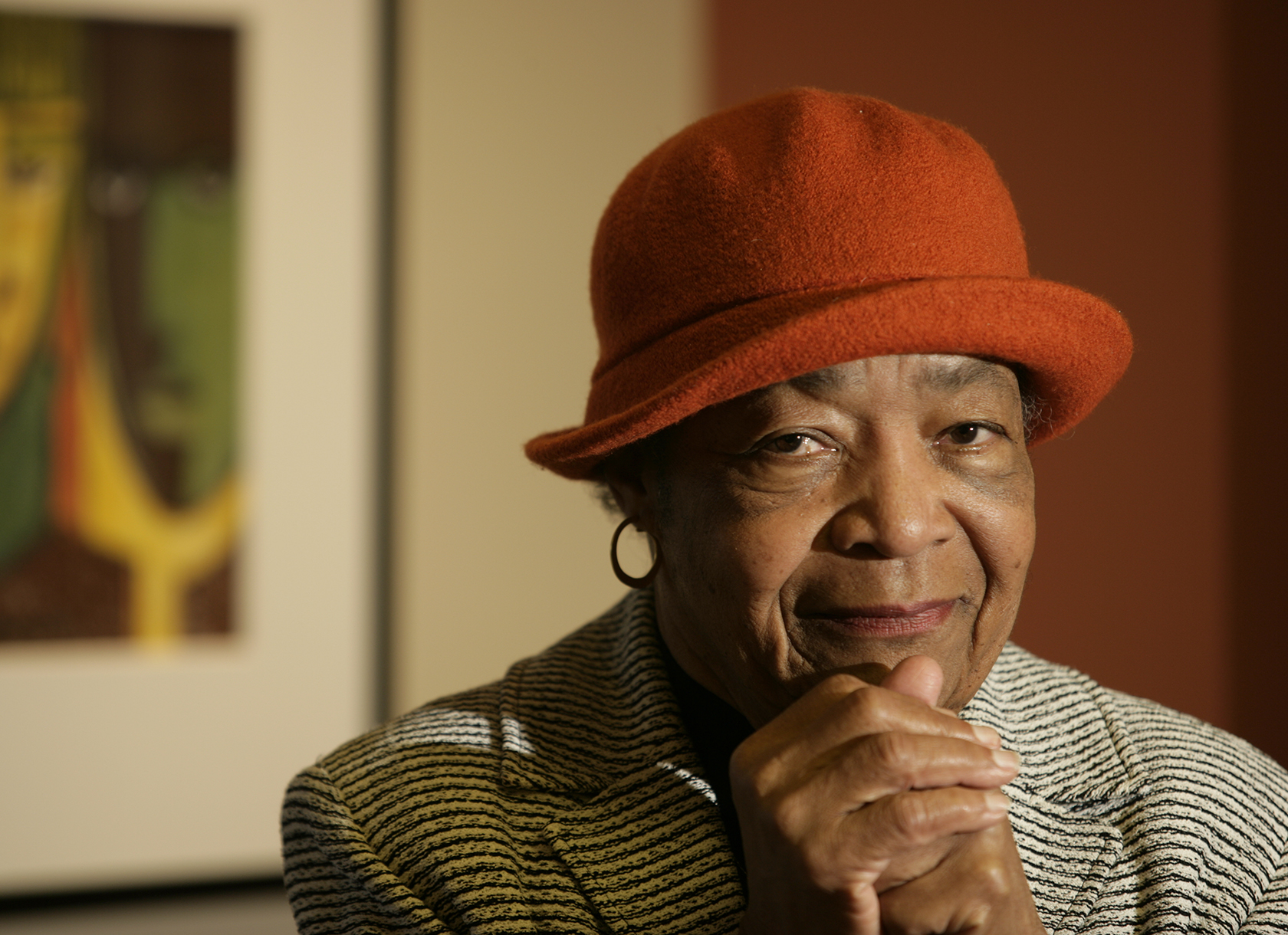By Emily Glory Peters

The words “no one has done that before” may deter some people from their goals—but they never stopped Dr. Samella Lewis, Scripps College’s first tenured Black professor and an iconic leader in the art world. An art historian, curator, and celebrated visual artist, Lewis devoted her life to spotlighting other Black creatives. She died in Torrance, California, on May 27, 2022, at the age of 99.
Born in New Orleans and brought up in Louisianna’s strawberry belt, Lewis showed artistic talent from a young age. After taking an undergraduate art course with her future mentor, artist Elizabeth Catlett, Lewis went on to obtain her bachelor’s degree from Hampton University and her MFA and two PhDs in visual arts and art history from The Ohio State University. She was the first Black woman to obtain a doctorate in fine arts.
In 1948, she married mathematician Paul G. Lewis, and they raised two sons together while she established her teaching career. Lewis went on to teach at Morgan State University, Florida A&M University, State University of New York, Plattsburg, and serve as a fellow at the University of Southern California before arriving at Scripps College, where she taught from 1970 to 1984.
The beginning of her academic tenure came at a time when few Black individuals, let alone Black women, were members of the Scripps faculty. Having collided in the past with institutions of higher education and museums about their explicit overemphasis on European art and minimization of Black artists, Lewis created a sea change in Scripps’ art history curriculum. Under her leadership, coursework embraced non-Western perspectives in art, including those from Africa, the Caribbean, and Asia.
“Samella was simply empowering. Whether it was her students she mentored, the artists she advocated for, or the museum professionals who sought her out, Samella never wavered,” says Kirk Delman, interim director of the Ruth Chandler Williamson Gallery at Scripps College. “She stood her ground, always mindful of what was the right thing to do. In every moment, Samella was her authentic self.”
Her influence on racial equity in art didn’t end there. Lewis opened no fewer than three galleries to promote artists of color, wrote seminal books on Black art that are used in classrooms to this day, and created a quarterly journal on Black art—an international publication she referred to as a “family operation.”
In 1976, she founded the Museum of African American Art (MAAA) in Los Angeles to preserve and raise support for the work of Black artists. She directed the MAAA for 10 years while continuing to teach at Scripps—and in 2007, the College honored her efforts by creating the Samella Lewis Contemporary Art Collection at the Ruth Chandler Williamson Gallery. The collection, which continues to acquire art by leading women and Black artists, includes many works by Lewis as well as by her mentor, Catlett, Jacob Lawrence, Alison Saar ’78, and other luminary creators.
“I had known Samella since the early ’70s as she was instrumental in furthering the careers of many Black artists in Los Angeles and throughout the US, including being one of the first curators to give my mother Betye Saar a solo exhibition,” explains Saar. “She was a brilliant scholar, an amazing artist, and a fierce advocate for Black artists around the world. Her diverse knowledge in the art of China, Africa, and Black artists in the United States and the African Diaspora in the Americas truly formed who I became as an artist—I am so grateful for her generosity and support.”
While Lewis’s legacy is defined by her role as an uncompromising champion for Black artists, she was first and foremost a teacher—and impacted many during and after her time teaching at Scripps.
Thanks to Lewis, the College was able to host remarkable speakers to connect with students, including Toni Morrison, Maya Angelou, and Catlett. To honor her time at Scripps and her impact on the lives of students of all backgrounds, a group of Scripps alumnae came together in 2003 to endow a scholarship in Lewis’s name. Designed to support Black Scripps students of distinction, today that scholarship has aided 20 recipients who have pursued careers as educators, human rights activists, and more.
“I have heard [Lewis] called ‘the godmother of Black art.’ My relationship with her and her amazing work provided me with a deep understanding of how critical African American artists have been to the art field, and how important art itself is to the African American experience,” says Crystal Jones ’85, a former Scripps Trustee and staff member who helped establish the fund. “We created her scholarship to solidify and celebrate Dr. Lewis’s legacy and concretize a place for African American students at Scripps.”
It’s tempting to summarize that legacy by her achievements—of which there are almost too many to number—but Lewis considered it more valuable to advance the achievements of others. And while her colleagues have described her as a “giant,” her students as inspiring, and her family as revolutionary, perhaps most poignant is how Lewis saw herself and the purpose of art in her life. As she shared in a film by Eric Minh Swenson:
“Art is not only a surprise, but something that endears you; you love it. And you’re not supposed to, you know—you’re supposed to be creating art for selling. I don’t create art for that. You can tell. I’m talking about experiences.”
Dr. Samella Lewis will forever be an honored part of Scripps College history. To make a gift to the scholarship in her name, please click here.

